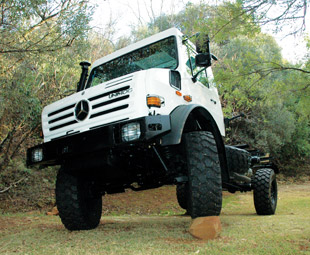Off-road maestro

The UNIversal-MOtor-Gerät (Gerät is German for machine or device), or the Unimog, as it’s known today, was initially intended to be a farm implement, as FOCUS discovered at a Unimog customer day…
Martin Flammer, head of training sales at Daimler AG in Wörth, Germany – where the Unimog is produced – visited South Africa for the customer day, and he is intimately familiar with the truck’s origins. “An aircraft engineer decided to come up with an idea for a vehicle that would be more capable and faster than a tractor,” he relates.
The engineer in question was Albert Friedrich, previously head of aeroengine design at Daimler-Benz AG. He had, in fact, been musing about designing a particularly innovative compact tractor for some time.
It was conceived as an agricultural vehicle, but it had to be superior to a conventional tractor. “The idea was to produce a four-wheel-drive vehicle that went faster than a tractor. He aimed for a top speed of up to 50 km/h. Furthermore, he wanted to invent a vehicle that had the behaviour of a horse; the centre of gravity is towards the front, so a horse pulls with all four legs,” explains Flammer.
Flammer reveals that the first Unimog was equipped with a tiny 18-kW (25-hp) engine. It was, in fact, the OM636 Daimler Benz diesel engine, which was utilised to power Mercedes’ 170D passenger car.
While many of the traits of the Unimog have remained unchanged (immense ground clearance, for instance), the vehicles have obviously gained power over the years. The U 5000 which we drove during the customer day, for instance, is equipped with the newly developed Mercedes-Benz OM 924 LA (this powerplant was created by enlarging the displacement of the OM 904 LA four-cylinder turbodiesel engine). This 4.8-l unit develops 160 kW (218 hp) of power at 2 200 r/min and peak torque of 810 Nm is available at 1 200 r/min.
 While the engine is a strong feature of the vehicle, the Mercedes-Benz transmission with electronic-pneumatic Telligent gearshift (EPS) and pneumatically selectable four-wheel drive is even more significant. Boasting eight forward and six reverse gears, it is quite sensational for tricky off-roading, in that it allows the driver the ability to travel at just 1.2 km/h without depressing the clutch. This is important when travelling off-road – go too fast and you will often dig in. We tested the Unimog at Gerotek and it didn’t blanch at any of the obstacles or gradients. Even the 100% gradient didn’t pose a challenge; it crawled up and down ever so easily.
While the engine is a strong feature of the vehicle, the Mercedes-Benz transmission with electronic-pneumatic Telligent gearshift (EPS) and pneumatically selectable four-wheel drive is even more significant. Boasting eight forward and six reverse gears, it is quite sensational for tricky off-roading, in that it allows the driver the ability to travel at just 1.2 km/h without depressing the clutch. This is important when travelling off-road – go too fast and you will often dig in. We tested the Unimog at Gerotek and it didn’t blanch at any of the obstacles or gradients. Even the 100% gradient didn’t pose a challenge; it crawled up and down ever so easily.
The torsionally flexible ladder frame of the Unimog, which consists of two U-shaped side members with welded tubular cross-members, is also a notable feature, in that it gives unimpeded flexing ability – you can actually see the chassis twist as the truck traverses obstacles off road. However, as Flammer points out, this does have body-building implications. “The body must be independently mounted on the frame so that no torsion is transferred [to the body],” he notes.
Then, of course, there is the ground clearance. “It has over 40 cm,” Flammer stresses.
Ultimately, these attributes have resulted in the Unimog acquiring cult status – it is used the world over by tour operators, in disaster aid, as a chassis for expedition vehicles, by municipal contractors and in military applications. “It is ideal for extinguishing fires, because the Unimog can go right to the fire. And it is used to inspect volcanoes because it is the one and only vehicle that can get there and then get back again,” notes Flammer. In fact, it is generally the number one choice in any extreme-terrain operation.
If Albert Friedrich were alive today, we reckon he would be ever so proud…
Published by
Focus on Transport
focusmagsa




